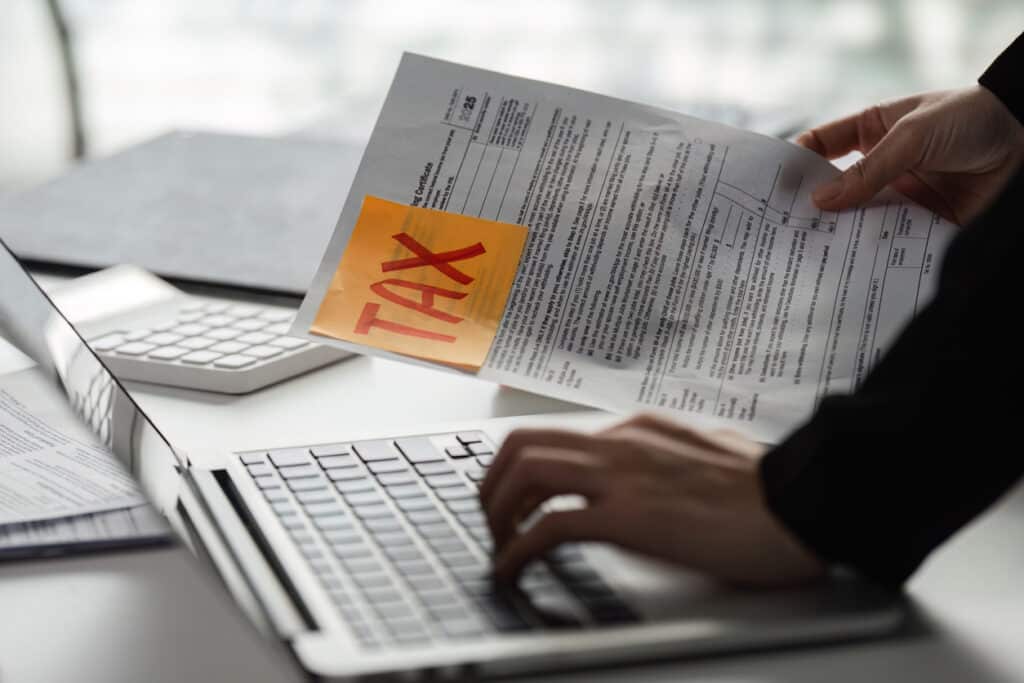Running a business across borders has its perks—new markets, global reach, maybe even better coffee at board meetings. The downside? Double taxation. Corporations with income from foreign countries or U.S. possessions often find themselves taxed twice on the same profits.
That’s where Form 1118 comes in. This IRS schedule allows corporations to claim the Foreign Tax Credit (FTC) and directly reduce their U.S. tax bill by the amount of qualifying foreign income taxes paid.
Handled correctly, Form 1118 can make a major dent in your corporate tax return. Handled sloppily, you’re stuck with a bigger liability than necessary—not exactly what shareholders like to hear.
📋 Key Updates for 2025
- The IRS’s official “About Form 1118” page continues to show no recent changes, confirming that the form and instructions remain stable and reliable for corporate tax filings.
- A new draft of Schedule L (Foreign Tax Redeterminations) for Form 1118 is in development, reflecting upcoming updates for corporations navigating contested foreign tax liabilities and redeterminations.
- The IRS updated Form 1118’s instructions on December 2023, indicating ongoing refinement of guidance while core form elements remain unchanged.
What is Form 1118?
Form 1118 is the IRS’s way of letting corporations say, “We’ve already paid tax on this once—let’s not do it again.” It’s the specialized tax form used by corporations to claim the Foreign Tax Credit for foreign income taxes paid on foreign source income during the current tax year.
Here’s how it fits into the corporate filing process:
- Form 1118 is filed as part of a U.S. corporation’s annual income tax return (Form 1120) when the corporation elects to claim the Foreign Tax Credit (FTC).
- It differs from Form 1116, which applies to individuals; Form 1118 is for corporations, and may also be used by individuals making a Section 962 election. Controlled foreign corporations (CFCs) themselves do not file Form 1118.
- The purpose is to reduce U.S. tax liability by crediting the amount of foreign income taxes already paid on foreign source income.
- The form separates multiple categories of income—such as general category income, passive category income, foreign branch income, and GILTI—each requiring its own calculation.
In short, Form 1118 ensures corporate profits aren’t taxed twice—once by a foreign government and again by the Internal Revenue Service—as long as you file it correctly.
💡 Pro Tip:
The more complex your global structure, the more likely it is you’ll need multiple versions of Form 1118—one for each separate category. Get this wrong, and your credits may not hold up under IRS scrutiny.
Who must file Form 1118?
Not every corporation with overseas ties needs to complete Form 1118. Filing is required if a corporation elects to claim the Foreign Tax Credit or has certain foreign loss account adjustments.
Who files:
- U.S. corporations that earn foreign source income and pay or accrue foreign income taxes, and elect to claim the FTC.
- Resident corporations: Companies based in the U.S. that choose to credit rather than deduct foreign taxes must attach Form 1118 to Form 1120.
- CFC income: U.S. shareholders of controlled foreign corporations don’t file 1118 on behalf of the CFC, but they may use Form 1118 to claim deemed-paid taxes related to Subpart F or GILTI inclusions.
- Separate schedules: A separate Form 1118 must be filed for each income category (general, passive, foreign branch, GILTI, etc.).
In short, if your corporation’s profits are being taxed abroad and you want to credit those taxes against your U.S. liability, Form 1118 is the vehicle to prevent double taxation.
💡 Pro Tip:
Corporations often underestimate the paperwork—Form 1118 isn’t “one and done.” Each category of foreign income gets its own schedule, which means the more complex your structure, the thicker your filing.
How the Foreign Tax Credit works for corporations
For corporations, the Foreign Tax Credit (FTC) is a direct way to cut U.S. tax costs. Instead of reducing taxable income, the credit lowers U.S. income tax liability dollar-for-dollar by the amount of foreign income taxes paid.
Here’s what you need to know:
- Foreign Tax Credit limitation: The IRS caps the FTC so corporations can’t claim more than the portion of U.S. tax attributable to their foreign source income. This limitation is calculated in Part I and Part II of Form 1118.
- Apportionment rules: Corporations must allocate and apportion expenses (like interest or R&D costs) between U.S. and foreign income. This determines how much of the total foreign taxes are actually creditable.
- Carrybacks and carryforwards: If foreign taxes exceed the allowable FTC in one year, the excess isn’t lost. Credits can be carried back one year or carried forward for up to 10 years, offering flexibility across business cycles.
💡 Pro Tip:
Corporations with operations in multiple jurisdictions should pay close attention to apportionment rules. Misallocating expenses can shrink allowable credits—and leave valuable tax savings on the table.
Breaking down IRS Form 1118
Form 1118 may look like alphabet soup at first glance, but every part and schedule has a purpose. The goal is to match foreign taxes paid with the correct type of foreign source income so that credits are calculated accurately.
- Part i, Part ii, Part iii: Summarize total foreign income and taxes, and establish the credit limitation.
- Schedule A: Reports foreign income or loss before adjustments.
- Schedule B: Reports foreign taxes paid or accrued directly by the U.S. corporation.
- Schedule C: Taxes deemed paid with respect to Subpart F inclusions (§960(a)).
- Schedule D: Taxes deemed paid with respect to GILTI inclusions (§960(d)).
- Schedule E: Taxes deemed paid with respect to PTEP (previously taxed earnings & profits, §960(b)).
- Schedule F: Reserved.
- Schedule G: Reductions of taxes paid, accrued, or deemed paid (e.g., treaty benefits, boycott rules).
- Schedule H: Apportionment of certain deductions (like interest or R&D).
- Schedule I: Reduction of foreign oil and gas taxes.
- Schedule J: Adjustments to separate limitation income (loss) categories and recharacterization accounts.
- Schedule L: Foreign tax redeterminations (when foreign governments change previously reported tax).
By requiring corporations to separate each category of income and tax, the IRS ensures that credits are not “mixed and matched” across categories. It’s more paperwork, but it preserves accuracy and prevents double counting.
💡 Pro Tip:
Don’t underestimate the complexity of the schedules. For large corporate taxpayers, it’s not unusual to file multiple versions of the same schedule for different subsidiaries or countries—turning Form 1118 into a hefty stack rather than a single form.
Special issues and complexities
While Form 1118 is designed to prevent double taxation, corporations with international income often face rules that make the calculation far from simple. From treaty benefits to foreign tax adjustments, the fine print can have a big impact on how much credit you’re actually allowed to claim.
- Tax treaties: Income tax treaties may lower the amount of foreign tax paid, which directly reduces the credit reported on Form 1118. These reductions must be carefully documented.
- Investment income: Special treatment applies to qualified dividends, capital gains, and lump-sum distributions, and misclassifying them can shrink your allowable credit.
- Foreign tax redeterminations: If a foreign authority later changes your tax bill, the IRS requires an amended return to reflect the new numbers.
- Currency conversions: All figures must be converted into U.S. dollars using the IRS’s functional currency rules, not market exchange rates.
- Documentation: Corporations must maintain proof of every step—foreign tax receipts, detailed calculations, and their employer identification number (EIN)—to back up their filing.
💡 Pro Tip:
The IRS cares just as much about how you support your numbers as the numbers themselves. Even a valid credit can be denied if the paperwork doesn’t line up.
Filing and deadlines
When it comes to claiming the Foreign Tax Credit, timing is everything. Form 1118 must be filed alongside your corporate tax return, and missing the deadline can mean losing credits you’ve already earned. Because the form ties directly into your Form 1120, it follows the same rules and deadlines.
- Due date: Form 1118 is due with Form 1120—typically the 15th day of the 4th month after the end of the tax year (April 15 for most calendar-year corporations).
- E-filing: Many corporations can file electronically, though the IRS may require supporting documents to be attached.
- Accuracy matters: Errors, omissions, or failing to account for reductions of taxes (like treaty benefits or refunds) can reduce the allowable credit and invite IRS scrutiny.
- Carryovers at stake: Timely and accurate filing protects your right to apply excess credits as carrybacks or carryforwards—a key benefit for corporations with fluctuating profits.
💡 Pro Tip:
Treat Form 1118 with the same priority as Form 1120. Late or sloppy filing doesn’t just risk penalties—it can erase years of future tax savings.
Keeping corporate taxes in balance
Form 1118 is one of the most powerful tools corporations have for managing the tug-of-war between foreign and U.S. taxation. Done right, it prevents the IRS from taxing the same profits twice, maximizes credit carryovers, and keeps your compliance airtight across multiple jurisdictions. Done wrong, it’s just another way to hand over more than you owe.
That’s where Bright!Tax can help. Our team understands the schedules, categories, and credit limitations that make Form 1118 so complex—and we know how to turn them into real savings for corporations operating worldwide. Get in touch today and let’s make your global tax strategy work smarter.
Frequently Asked Questions
-
Who must file Form 1118?
Any U.S. corporation that elects the Foreign Tax Credit must file Form 1118 with its corporate tax return (Form 1120). In addition, corporations with foreign tax redeterminations or loss account adjustments may have to attach certain schedules even if no credit is claimed.
-
How is Form 1118 different from Form 1116?
Form 1116 is used by individuals to claim the FTC on their personal returns, while Form 1118 applies to corporations electing the credit. Individuals making a Section 962 election (to be taxed like a corporation on certain CFC income) may also need to file Form 1118. CFCs themselves do not file Form 1118.
-
Do I need to complete all the schedules (A–J)?
Not necessarily. You only complete the schedules that apply to your corporation’s activities—for example, Schedule A for taxes deemed paid through subsidiaries or Schedule I for CFC inclusions.
-
What counts as foreign source income for Form 1118?
Income earned outside the U.S., including general category income, passive income, foreign branch income, and GILTI inclusions. Each category must be reported separately.
-
Can excess credits be carried forward?
Yes. If your foreign tax credits exceed your U.S. liability for the current tax year, the excess can be carried back one year or carried forward for up to ten years.
-
What records do I need to support Form 1118?
Corporations should maintain foreign tax receipts, allocation and apportionment calculations, and supporting documentation for any reductions of taxes (like treaty benefits).
-
Why should a corporation work with a tax professional?
Because Form 1118 is one of the most complex IRS filings. A qualified CPA can help ensure compliance, maximize credits, and keep your corporation’s U.S. tax liability as low as possible across jurisdictions.

 Connect on LinkedIn
Connect on LinkedIn

